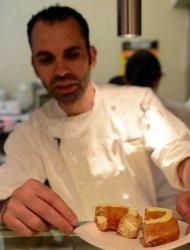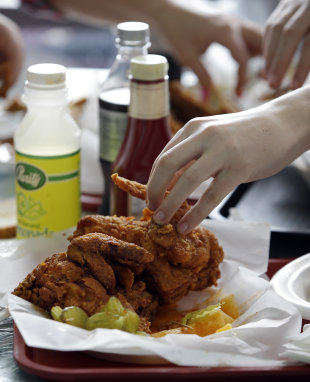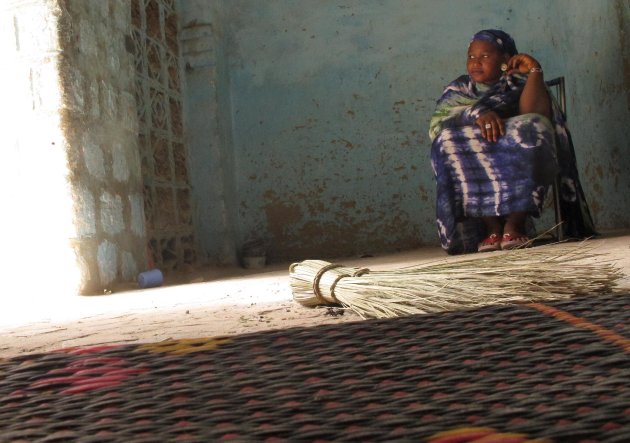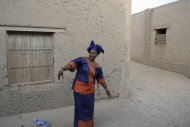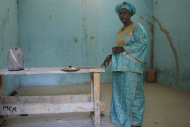TIMBUKTU, Mali (AP) — The love story in this fabled desert outpost began over the phone, when he dialed the wrong number. It nearly ended with the couple's death at the hands of Islamic extremists who considered their romance "haram" — forbidden.
What happened in between is a study in how al-Qaida-linked militants terrorized a population, whipping women and girls innorthern Mali almost every day for not adhering to their interpretation of the strict moral code known as Shariah. It is also a testament to the violent clash between the brutal, unyielding Islam of the invaders and the moderate version of the religion that has long prevailed in Timbuktu, once a center for Islamic learning.
Salaka Djicke is a round-faced, big-boned girl with the wide thighs still fashionable in the desert, an unforgiving terrain that leaves many women without curves. Until the Islamists came and upended her world, the 24-year-old lived a relatively free life.
During the day, she helped her mother bake bread in a mud oven, selling each puffy piece for 50 francs (10 cents). In the afternoon, she grilled meat on an open fire and sold brochettes on the side of the road. She saved the money she earned to buy herself makeup and get her hair styled.
Like her sisters and friends, she spoke openly with men — including the stranger who called her by mistake more than a year ago.
The man thought he was calling his cousin. When he heard Salaka's voice, he apologized. His voice was polite but firm, with the authoritative cadence of a man in his prime. Hers was flirtatious, and her laugh betrayed her youth.
They started talking.
A few days later, he called her again. For two weeks, they spoke nearly every day, until he asked for directions to her house.
She explained how to find the mud house on Rue 141, past the water tower also made of mud, in a neighborhood less than a mile from where he sold gasoline from jerrycans by the roadside. She had time to put on a yellow dress.
He arrived on his motorcycle.
He was older — she does not know how old — and already married, a status that bears no taboo in a predominantly Muslim region where men can take up to four wives. She found him handsome.
From that day on, he ended phone conversations with the phrase, 'Ye bani,' or "I love you" in the Sonrai language. Instead of Salaka, he called her "cherie" — sweetheart in French, still spoken in this former French colony.
He showered her with gifts, starting with a 6-yard-long piece of bazin fabric, the hand-dyed, polished cotton which is the mainstay of Malian fashion. It was a royal violet, and he paid to have it tailored into a two-piece outfit, with a flame-like flourish of orange brocade on the bodice.
She put it on for him, and they went to the photo studio one street over. They stood against the poster backdrop of an enamel-blue waterfall. He put his arms around her and invited her to sit on his lap.
By the time the first group of rebel fighters carrying the flag of the National Movement for the Liberation of the Azawad drove past her house on April 1, the two had been seeing each other for several months. He called to see if she was OK.
These fighters in military uniforms made clear their goal: They wanted to create an independent homeland known as Azawad for Mali's marginalized Tuareg people.
Only days later, a different group of fighters arrived, wearing beards and tunics that looked like the kurtas common in Pakistan and Afghanistan. Their black flag resembled the one people had seen on YouTube videos posted by al-Qaida in the Islamic Maghreb. They called themselves Ansar Dine, or "Defenders of the Faith."
They produced a pamphlet outlining how a woman should wear the veil, and whom she could and could not be seen with. Eschewing any contact with women, they handed the leaflets out to the men.
One of them was Salaka's boyfriend. He drove his motorcycle to her house to give it to her.
She didn't have enough money to buy the plain, colorless veil prescribed to cover the entire body. So her boyfriend went to the market and paid for two, one red and one blue. The women of sub-Saharan Africa are so used to wearing vibrant colors, he couldn't find any that were black.
___
As their love affair grew more intense, so did the crackdown by the Islamists in northern Mali, an area equal in size to Afghanistan.
Three months after they arrived, they arrested an illiterate man and woman, both dirt-poor herders living together for years with their animals outside the town of Aguelhok. The man had left his wife to reunite with his teenage love, and they had two children out of wedlock, the youngest just six months old.
In the last week of July, the Islamists sped into their nomadic camp and arrested them. They drove them to the city center, where they announced the couple would be stoned to death for adultery.
They dug a hole the size of a man and forced them to kneel inside. They made the villagers come out to see what Shariah was.
Then they cast the first stone.
__
The fear was now palpable on the streets of Timbuktu. Salaka and her boyfriend stopped seeing each other in public. When he came, they sat in the enclosed courtyard of her parents' home, behind the veil of its chrome-red dirt walls.
Even in relatively modern Timbuktu, it was not considered appropriate to leave the couple alone in a room. So he arranged for a friend to loan him the keys to his empty house in a neighborhood less than a mile away.
Would she please join him there, just for an hour, once a week?
She hesitated. He begged her, saying he couldn't be without her. They determined that the Islamic police stopped their patrols at 10 p.m.
She went once and got home safely. She went again.
They began meeting once a week. She insisted on staying no longer than 40 minutes. He brought her on his motorcycle, stopping close to the house and pushing the bike through a blanket of sand to avoid attention.
By this time, the Islamists were beating everyone from pregnant mothers and grandmothers to 9-year-olds for not covering themselves fully. A woman was no longer supposed to talk even to her own brother on the stoop of her house.
At a certain point Salaka knew they were going to get caught. She planned out what they would say.
In one version, she would say he was her uncle. In another she would call him her older brother. In yet another, they would try to pass off as a married couple.
On the night of Dec. 31, the two left Salaka's house on a motorcycle, headed west and turned onto Road No. 160.
They passed the bread oven belonging to one of her mother's competitors. They skirted an alley crowded with handmade bricks laid out to dry. They turned left, and then right again, taking a circuitous path to confuse anyone who might be following them.
When they got close, they chose the narrowest alleyways, used only by motorcycles and donkey carts instead of the Toyota pickup trucks of the Islamic police. They passed the house where they planned to meet and doubled back in an alley. He cut the motorcycle's engine, told her to stay 100 yards behind him and pushed the bike through the sand as usual.
She watched him leave. She was breathing so hard she was afraid the stars could hear her. He passed the first intersection, then the second, and then the third.
The bearded men came on foot via the third intersection. There were four of them. Her lover jumped on his motorcycle and gunned it across the sand. He was the married one and would have paid the higher price.
She knew she couldn't outrun them. So she stood. And in the moments it took for them to descend on her, she realized it would be futile to lie.
___
They took her to the headquarters of the Islamic police, inside a branch of the local bank. They shoved her into the closet-like space where the ATM machine is located and locked the gate behind her.
When she didn't come home that night, her worried sister called her cell phone. The Islamic police answered and told her where Salaka was.
In the morning, her family came to slip her a piece of bread through the grills of the gate, feeding her like an animal at the zoo. Later that day, the police transferred her to a prison they had set up just for women in a wing of the city's central jail. For the next three nights, she slept alone on a hard floor in a large, cement room.
On Jan. 3 they took her to the Islamic tribunal. Just eight days before French President Francois Hollande unilaterally approved a military intervention in Mali on Jan. 11, Salaka was convicted of being caught with a man who was not her husband and sentenced to 95 lashes. It was a severe punishment even by the standards of the Islamists.
They took her to the market at noon on Jan. 4, the same place where she bought the beef for the brochettes she sold and the flour used to make her mother's flatbread. She recognized the meat sellers. One of them used his phone to record what happened next.
The police made her kneel in a traffic circle. They covered her in a gauze-like shroud. They told her to remove her dress, leaving only the thin fabric to protect her skin from the whip. Curious children jostled for a better view.
What they did to her was witnessed by dozens of people in Timbuktu, and can still be heard on the meat seller's cell phone.
The executor announced Salaka's crime and her punishment. Then he began flogging her with a switch made from the branch of a tree. Her high-pitched cries are contorted with pain. You can hear the slap of the whip. You can hear her labored breathing.
They hit her so hard and for so long that at one point she wasn't sure if the veil had fallen off. She could feel the blood seeping through.
When it was over, they told her that if they ever saw her with a man again, they would kill her.
Her lover called as soon as she got home. The night she was caught, he ran away to Mali's distant capital, becoming one of an estimated 385,000 people who have fled their homes from the north.
He said over and over: "I'm sorry." He promised to marry her. But he has not yet returned. She still will not name him, fearing the Islamist extremists will be back.
Her face warms when she speaks of him and contracts when she describes her pain and humiliation. There isn't a child in Timbuktu who doesn't recognize her, she says. Even now she avoids the market, sending her sisters to buy the meat instead.
"This was a tyrannical regime, which had no pity towards women," she says. "I'm not the only one that went through this. I did this because I was in love."
Last week, Salaka was among the thousands of people who poured into the streets to cheer French soldiers as they liberated the city. She folded and put away her blue and red veils.
In recent days, she pulled out her lover's gift of the violet bazin with the flame-patterned brocade from the bottom of a pile of clothes she was not allowed to wear under the city's occupiers. She painted her lips a translucent fuschia. She went to the newly opened hairdresser.
The photo studio where she and her lover posed by the cardboard waterfall remains closed, so instead her brother snapped a picture of her.
If you look closely, you can see the marks left by the whip across her now-naked shoulders.
___
Salaka's story was pieced together from interviews with her over three days. Salaka took AP journalists to the rendezvous house, the place where she was arrested, the ATM machine, her prison cell and the market. Her family, city officials and several witnesses confirmed the whipping, and a meat seller shared with the AP a sound recording that captures the sentencing and her screams. The account of the stoning in Aguelhok is from the city's mayor.
Rukmini Callimachi can be reached at www.twitter.com/rcallimachi.






